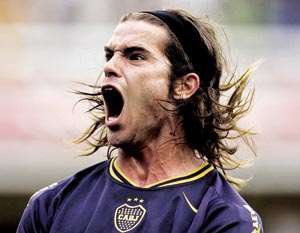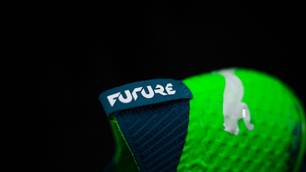10 to watch in 2007
Page 7 of 13 | Single page
Having single-handedly reversed the fortunes of Boca Juniors, the new Fernando Redondo sets his sights on conquering Europe with Real Madrid
AGE 20
CLUB Boca Juniors
POSITION Midfielder
LOWDOWN His grace and grit could revolutionise Real Madrid’s midfield
“Just as in the desert you can find a flower, in the histrionic league of Argentina has appeared a boy that thinks fast, passes quick and wants to play all the time. That is a blessing. Indeed, a miracle,” says Jorge Valdano. The player he speaks of is Fernando Gago. And from the moment he first wore a Boca Juniors first-team shirt as an 18-year-old in December 2004, it was obvious that the Buenos Aires giants had not only unearthed a natural-born footballer, but a natural-born leader too.
Just as the young Academy lad John Terry snapped fearlessly at senior Chelsea players, Gago barked out orders as though he was a seasoned Boca professional, caring not if his gestures were directed at fragile youngsters or players 15 years his senior.
Rather than crumbling under the pressure of coming into a crisis-hit team who played dull football, the young central midfielder ensured his new team-mates played to his tune. Short passes and constant movement, with the ball delivered to feet, were enough to transform Boca into a different team, almost overnight. Magazine El Grafico explained that the difference with Gago on the pitch was as obvious as watching a film on a small, portable TV and switching to a home cinema with Dolby surround sound.
Playing with such elegance and authority, Gago quickly gained the respect of his team-mates, while neutral observers hailed the emergence of Argentina’s most gifted No. 5 (as holding central midfielders are known in Argentina) since Fernando Redondo. Among those observers was Redondo himself.
“I used to imitate Redondo’s movements and the things that I always liked about him were his elegance, how he defended and how he always offered the team a solution,” explains Gago. “And it was a real surprise to me when I read that he was praising me about these same qualities. I mean, it was the footballer from my posters speaking about me!”
Unlike his idol, Gago is predominantly right-footed, but the similarities aren’t lost on anyone. “That kid plays as though he has his neck broken, it’s incredible. He never looks down,” says Alfio Basile, Gago’s Boca coach who’s now back in Argentina’s hot seat. “He will be the axis around which the future Argentina will be built. I’ve managed Redondo in 1994 and Gago at Boca; the resemblance is incredible. With Gago, a team can play smoother, simpler and quicker.”

Typically, Diego Maradona had his say too: “Only the five biggest clubs in the world are in his category.” As FourFourTwo goes to press, two of those clubs, Real Madrid and Barcelona, are vying for Gago’s signature, with a $30m price tag mooted and Gago said to prefer the capital club. Boca president Mauricio Macri admits the club will be forced to sell once the current European season ends. ‘The Little Prince’ says he would prefer to play in Spain, rather than Italy or England, yet it’s a current Serie A star who learnt his trade in the Premiership who Gago most admires in today’s game. “Patrick Vieira has a physical presence that is stunning,” he says. “And he is very good at attacking, not just sitting back or covering gaps. I love the way he plays. [Andrea] Pirlo is very good, too, but you can see he originally was an attacking midfielder. He doesn’t mark so much.”
Defending is an art that often goes unnoticed in Gago’s game, but playing for a club who celebrate a tackle as much as a nutmeg, he quickly set about convincing the fans that he didn’t mind getting his shorts dirty. Thankfully, he’d already had plenty of practice. “I used to be the anchorman in a 4-3-3 formation for the Boca academy team and I had to mark the opposition’s No. 10.”
But it’s in possession of the ball that he really excels. Maradona described Gago’s style as that of a windscreen wiper, swinging the ball left and right, constantly on the move. When he receives the ball again, as is often the case, he is invariably free of markers, though not for want of trying on the opposition’s part. “At the beginning I was shocked to see that I had one or two players following me closely, because I’m not a No. 10,” he says, “but it’s all a matter of having patience and finding the gaps. If there are two players close to me, then there’s got to be space elsewhere.”
And invariably, Fernando Gago will find it, as European audiences will discover from next season.
AGE 20
CLUB Boca Juniors
POSITION Midfielder
LOWDOWN His grace and grit could revolutionise Real Madrid’s midfield
“Just as in the desert you can find a flower, in the histrionic league of Argentina has appeared a boy that thinks fast, passes quick and wants to play all the time. That is a blessing. Indeed, a miracle,” says Jorge Valdano. The player he speaks of is Fernando Gago. And from the moment he first wore a Boca Juniors first-team shirt as an 18-year-old in December 2004, it was obvious that the Buenos Aires giants had not only unearthed a natural-born footballer, but a natural-born leader too.
Just as the young Academy lad John Terry snapped fearlessly at senior Chelsea players, Gago barked out orders as though he was a seasoned Boca professional, caring not if his gestures were directed at fragile youngsters or players 15 years his senior.
Rather than crumbling under the pressure of coming into a crisis-hit team who played dull football, the young central midfielder ensured his new team-mates played to his tune. Short passes and constant movement, with the ball delivered to feet, were enough to transform Boca into a different team, almost overnight. Magazine El Grafico explained that the difference with Gago on the pitch was as obvious as watching a film on a small, portable TV and switching to a home cinema with Dolby surround sound.
Playing with such elegance and authority, Gago quickly gained the respect of his team-mates, while neutral observers hailed the emergence of Argentina’s most gifted No. 5 (as holding central midfielders are known in Argentina) since Fernando Redondo. Among those observers was Redondo himself.
“I used to imitate Redondo’s movements and the things that I always liked about him were his elegance, how he defended and how he always offered the team a solution,” explains Gago. “And it was a real surprise to me when I read that he was praising me about these same qualities. I mean, it was the footballer from my posters speaking about me!”
Unlike his idol, Gago is predominantly right-footed, but the similarities aren’t lost on anyone. “That kid plays as though he has his neck broken, it’s incredible. He never looks down,” says Alfio Basile, Gago’s Boca coach who’s now back in Argentina’s hot seat. “He will be the axis around which the future Argentina will be built. I’ve managed Redondo in 1994 and Gago at Boca; the resemblance is incredible. With Gago, a team can play smoother, simpler and quicker.”

Typically, Diego Maradona had his say too: “Only the five biggest clubs in the world are in his category.” As FourFourTwo goes to press, two of those clubs, Real Madrid and Barcelona, are vying for Gago’s signature, with a $30m price tag mooted and Gago said to prefer the capital club. Boca president Mauricio Macri admits the club will be forced to sell once the current European season ends. ‘The Little Prince’ says he would prefer to play in Spain, rather than Italy or England, yet it’s a current Serie A star who learnt his trade in the Premiership who Gago most admires in today’s game. “Patrick Vieira has a physical presence that is stunning,” he says. “And he is very good at attacking, not just sitting back or covering gaps. I love the way he plays. [Andrea] Pirlo is very good, too, but you can see he originally was an attacking midfielder. He doesn’t mark so much.”
Defending is an art that often goes unnoticed in Gago’s game, but playing for a club who celebrate a tackle as much as a nutmeg, he quickly set about convincing the fans that he didn’t mind getting his shorts dirty. Thankfully, he’d already had plenty of practice. “I used to be the anchorman in a 4-3-3 formation for the Boca academy team and I had to mark the opposition’s No. 10.”
But it’s in possession of the ball that he really excels. Maradona described Gago’s style as that of a windscreen wiper, swinging the ball left and right, constantly on the move. When he receives the ball again, as is often the case, he is invariably free of markers, though not for want of trying on the opposition’s part. “At the beginning I was shocked to see that I had one or two players following me closely, because I’m not a No. 10,” he says, “but it’s all a matter of having patience and finding the gaps. If there are two players close to me, then there’s got to be space elsewhere.”
And invariably, Fernando Gago will find it, as European audiences will discover from next season.
Related Articles

PUMA reveals new 'Stun Pack'

PUMA Future 18.1 up close













